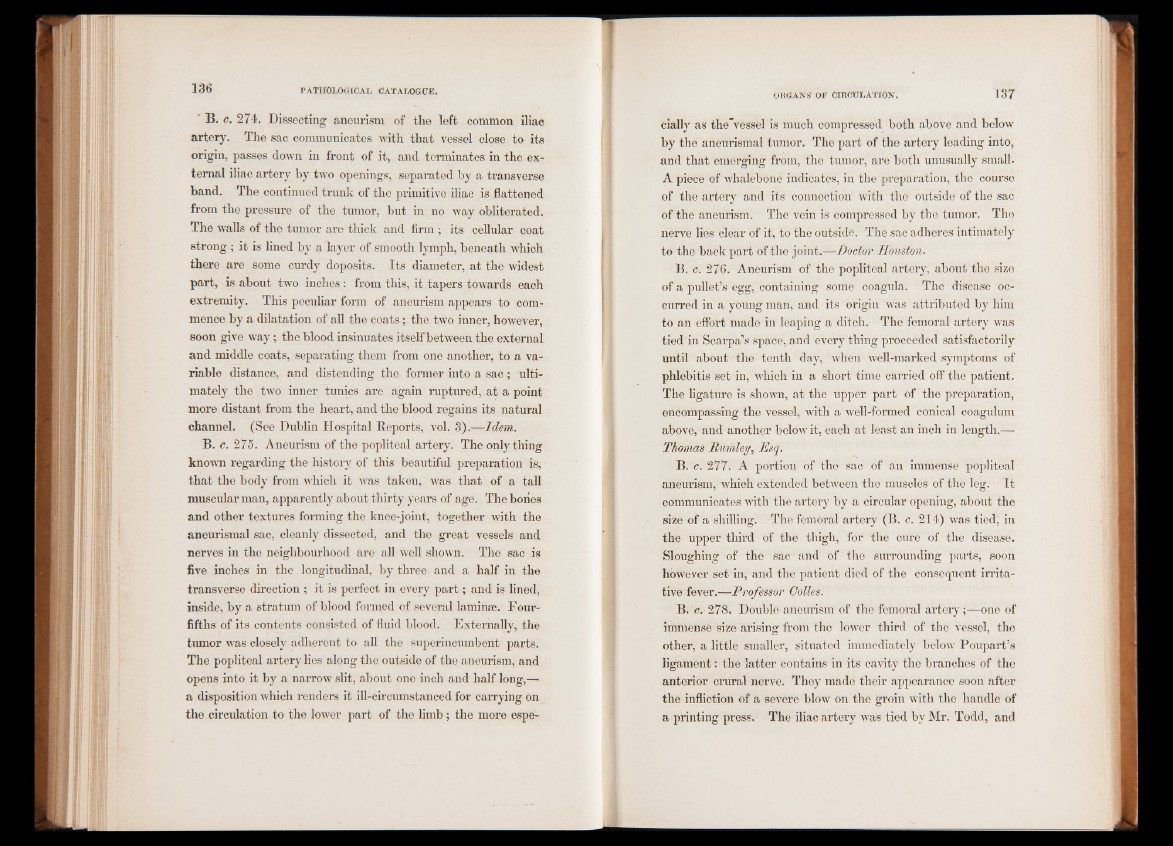
' B. c. 274. Dissecting aneurism of the left common iliac
artery. The sac communicates with that vessel close to its
origin, passes down in front of it, and terminates in the external
iliac artery by two openings, separated by a transverse
band. The continued trunk of the primitive iliac is flattened
from the pressure of the tumor, but in no way obliterated.
The walls of the tumor are thick and firm ; its cellular coat
strong ; it is lined by a layer of smooth lymph, beneath which
there are some curdy doposits. Its diameter, at the widest
part, is about two inches: from this, it tapers towards each
extremity. This peculiar form of aneurism appears to commence
by a dilatation of all the coats; the two inner, however,
soon give way; the blood insinuates itself between the external
and middle coats, separating them from one another, to a variable
distance, and distending the former into a sac ; ultimately
the two inner tunics are again ruptured, at a point
more distant from the heart, and the blood regains its natural
channel. (See Dublin Hospital Reports, vol. 3).—Idem.
B. c. 275. Aneurism of the popliteal artery. The only thing
known regarding the history of this beautiful preparation is;
that the body from which it was taken, was that of a tall
muscular man, apparently about thirty years of age. The bones
and other textures forming the knee-joint, together with the
aneurismal sac, cleanly dissected, and the great vessels and
nerves in the neighbourhood are all well shown. The sac is
five inches in the longitudinal, by three and a half in the
transverse direction ; it is perfect in every part; and is lined,
inside, by a stratum of blood formed of several laminae. Four-
fifths of its contents consisted of fluid blood. Externally, the
tumor was closely adherent to all the superincumbent parts.
The popliteal artery lies along the outside of the aneurism, and
opens into it by a narrow slit, about one inch and half long,—
a disposition which renders it ill-circumstanced for carrying on
the circulation to the lower part of the limb ; the more especially
as the’vessel is much compressed both above and below
by the aneurismal tumor. The part of the artery leading into,
and that emerging from, the tumor, are both unusually small-
A piece of whalebone indicates, in the preparation, the course
of the artery and its connection with the outside of the sac
of the aneurism. The vein is compressed by the tumor. The
nerve lies clear of it, to the outside. The sac adheres intimately
to the back part of the joint.—Doctor Houston.
B. c. 276. Aneurism of the popliteal artery, about the size
of a pullet’s egg, containing some coagula. The disease occurred
in a young man, and its origin was attributed by him
to an effort made in leaping a ditch. The femoral artery was
tied in Scarpa’s space, and every thing proceeded satisfactorily
until about the tenth day, when well-marked symptoms of
phlebitis set in, which in a short time carried off the patient.
The ligature is shown, at the upper part of the preparation,
encompassing the vessel, with a well-formed conical coagulum
above, and another below it, each at least an inch in length.—■
Thomas Eumley, Esq.
B. c. 277. A portion of the sac of an immense popliteal
aneurism, which extended between the muscles of the leg. It
communicates with the artery by a circular opening, about the
size of a shilling. The femoral artery (B. c. 214) was tied, in
the upper third of the thigh, for the cure of the disease.
Sloughing of the sac and of the surrounding parts, soon
however set in, and the patient died of the consequent irritative
fever.—Professor Colies.
B. c. 278. Double aneurism of the femoral artery;—one of
immense size arising from the lower third of the vessel, the
other, a little smaller, situated immediately below Poupart’s
ligament: the latter contains in its cavity the branches of the
anterior crural nerve. They made their appearance soon after
the infliction of a severe blow on the groin with the handle of
a printing press. The iliac artery was tied by Mr. Todd, and